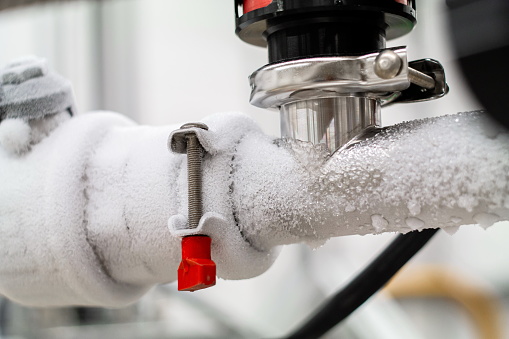
Winter can be a magical time of year. It’s hard not to love the peaceful blanket of white that a fresh snowfall brings or those cozy nights bundled up by the fireside. But it’s also pretty easy for those delightful winter moments to get completely derailed by a sudden pipe burst or leak when Jack Frost starts really showing off.
The truth is, frozen pipes are extremely common in both the cold and the heat. Quick temperature changes, poor insulation, or incorrect use of your thermostat can all contribute to the cause, and unfortunately, the consequences are not nearly as simple — they’re a massive pain.
So in order to prevent your pipes from freezing this season, add the following to-do’s to your pipe maintenance checklist!
- Check for all unheated areas. Check for unheated areas of your home where water lines are exposed. Consider the garage, attic, and under kitchen and bathroom cabinets. These areas can be easily forgotten and will get a lot colder than the rest of your house, so make sure they’re properly insulated or at least your pipes are — which leads us to #2!
- Insulate your pipes. Exposed pipes are more susceptible to freezing, so make sure all pipes that are in attics, crawl spaces, garages, and other unfinished spaces are properly insulated. There are a number of ways to do this, including wrapping pipes in heat tape, insulation strips, or thermostatically-controlled heat cables.
- Drain water. Make sure your swimming pool and water sprinkler supply lines are all empty as instrucred by the manufacturer/installer’s instructions. Close inside valves supplying those outside hose bibs so that water can also drain, and keep them open so that any remaining water can expand without bursting the pipe.
- Seal or caulk cracks. Take a look for any leaks around your electrical, dryer vents, and water pipes. These cracks can let in cold air that make pipes more susceptible to freezing, especially those running inside to outside.
- Let water drip. When it’s really cold outside, let the water drip from the faucet of the cold pipes. By running even just a trickle of water through the pipes, they are less likely to freeze than if there’s sitting water inside them.
- Adjust your thermostat. Setting your thermostat to the same temperature during the day and at night is not only a great way to avoid overworking your furnace, but it also prevents pipes from getting too cold when those temperatures hit their lowest overnight. Similarly, if you’re going away, don’t turn your heat completely off! Keep the heat set to about 55-60° F.
- Open cabinet doors. Try to regularly open cabinets and vanities to allow some warm air in. This will prevent those un-insulated pipes under sinks and appliances from getting too cold.
- Shut off the water. There’s really no reason to have your garden hose hooked up in the dead of winter. Turn off these water sources and drain the system so there’s no remaining water that could freeze. But keep in mind, if you have an internal fire protection sprinkler system, this may also deactivate it as well.
How to Thaw Your Frozen Pipes
If you’re reading this blog a little too late and have unfortunately already discovered some frozen pipes, don’t worry. There are some tricks to thaw them out before they start cracking or leaking.
- First, call a neighbor. If they are experiencing a similar issue in regard to their water flow, it may be the result of a main break. If not, your pipes are probably frozen.
- Go to the main valve and turn off the water asap.
- Open the faucet so that water will flow through the pipe as it melts. This will also aid in the melting process.
- Apply heat around the pipe using a hair dryer, electric heating pad, or portable space heater. But don’t let the water get to a boil — if it’s that hot, you could also damage the pipes.
- Check your pipes for any cracks the freezing may have caused, as well as pools of water that indicate a leak.
- If you can’t locate the frozen pipes or are unable to reach them, call a professional to come out and take a look. They’ll have the right equipment to help you thaw them out.
For help protecting your pipes this winter, or to have a licensed professional make sure you’re ready for winter’s worst, contact our team at Madsen today!


